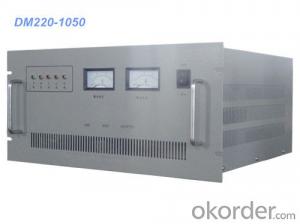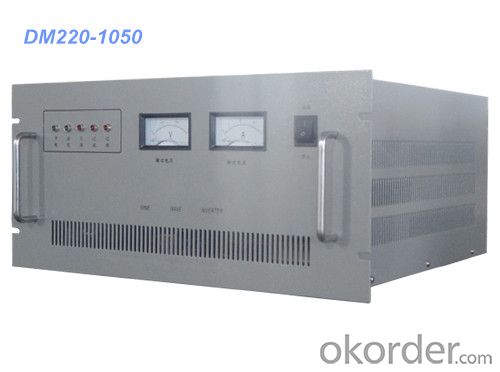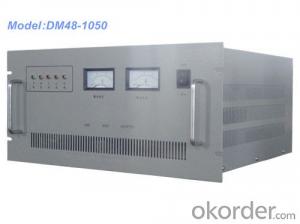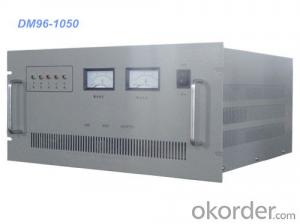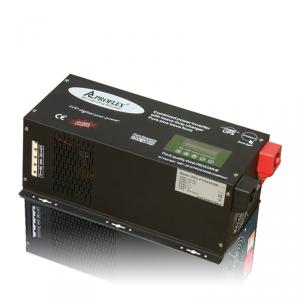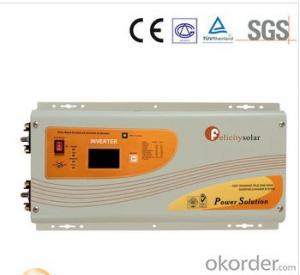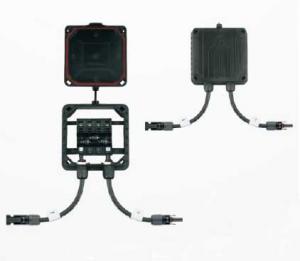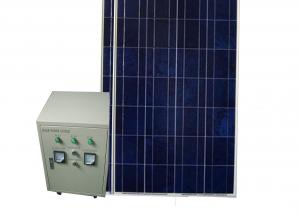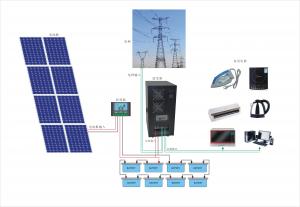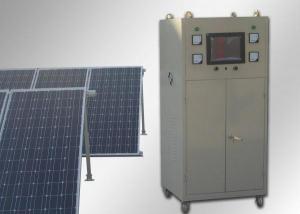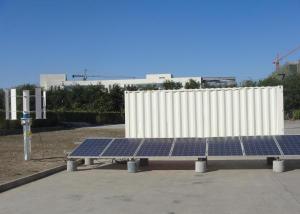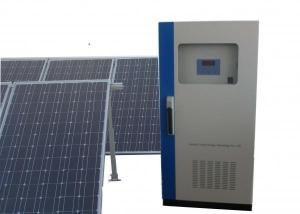Mountaintop Solar Energy Systems - Pure Sine Wave Inverter/ Solar Power Inverter 5kVA 220V with Isolate Transformer
- Loading Port:
- Qingdao
- Payment Terms:
- TT OR LC
- Min Order Qty:
- 1 unit
- Supply Capability:
- 800 unit/month
OKorder Service Pledge
OKorder Financial Service
You Might Also Like
Specifications
1.using IGBT from Mitsubishi company
2.using American ATEMEL company microprocessor
3.Max. Efficiency>94%
Features:
1. using IGBT from Mitsubishi company as the power components
2. using American ATEMEL company microprocessor as figure controller
3. perfect protection and warning functions
4. circuit frame compact,Max. Efficiency≥94%
5. with wide input voltage range
6. RS232/485 communication,multi communication interface can be selected
7. big-screen English LCD, perfect display, interface-friendly
Off Grid Pure Sine Wave Inverter 5KW 96/110/120V for wind power and PV power with factory price
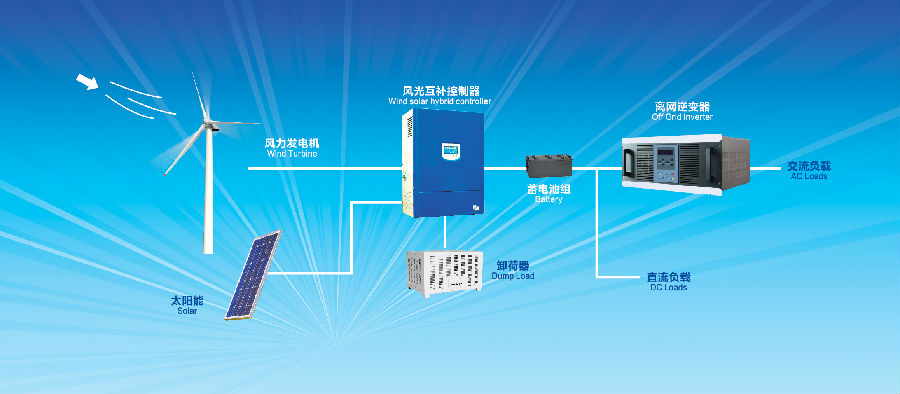
Technical Data Sheet
Type | ND220-5KD | ||||
DC input | Input rated voltage | 220 VDC | |||
Input rated current | 22.7 A | ||||
Input DC voltage range | 180-300 VDC | ||||
AC input | Allow input voltage range | 110 VAC / 120 VAC / 220 VAC / 240 VAC ± 15% | |||
Input rated current | 45.5A / 41.7A / 22.5 A / 21A | ||||
Bypass transfer time | ≦4 ms | ||||
AC output | Rated capacity | 5KVA | |||
Output rated power | 4KW | ||||
Output rated voltage and frequency | 110 VAC / 120 VAC / 220 VAC / 240 VAC,50Hz / 60Hz | ||||
Output rated current | 45.5A / 41.7A / 22.5 A / 21A | ||||
Output voltage accuracy | 110 VAC / 120 VAC / 220 VAC / 240 VAC± 2% | ||||
Output frequency accuracy | 50Hz / 60Hz ± 0.05% | ||||
Waveform distortion (THD). | ≤3% | ||||
Dynamic response time | 5% | ||||
Power factor (PF) | 0.8 | ||||
Overload capacity | 120%,3minutes,150%,10second | ||||
Crest factor (CF) | 3:1 | ||||
Inverter efficiency | 90% | ||||
Working Environment | Dielectric strength | 1500VAC,1minute | |||
Noise (1m) | ≤50dB | ||||
Ambient temperature | -10℃~+50℃ | ||||
Humidity | 0~90%,No condensation | ||||
Altitude | ≤5000 m | ||||
Industrial Frequency Transformer | Yes | ||||
Production function | Input reverse protection, input under-voltage protection, output overload protection, output short circuit protection, thermal protection | ||||
Dimensions | 482*420*223mm | ||||
Weight | 52kg | ||||
- Q: Can solar energy systems be installed on schools or educational institutions?
- Yes, solar energy systems can be installed on schools or educational institutions. In fact, many schools and educational institutions have already adopted solar energy systems as a way to reduce their carbon footprint, save on energy costs, and provide real-life examples of renewable energy to students. These systems can be installed on rooftops, parking lots, or open spaces, depending on the available area and energy requirements of the institution.
- Q: How does a solar energy system work?
- A solar energy system works by capturing sunlight using photovoltaic (PV) panels or solar thermal collectors. The PV panels convert sunlight directly into electricity by using semiconductor materials, while solar thermal collectors use sunlight to heat water or air for various purposes. The electricity generated by the PV panels can be used to power homes or businesses, or it can be stored in batteries for later use. Additionally, excess electricity can be fed back into the grid for credit or sold to utility companies. Overall, solar energy systems harness the power of the sun to provide clean and renewable energy.
- Q: Can solar energy systems be used in powering disaster relief centers or emergency shelters?
- Solar energy systems can indeed be used to power disaster relief centers or emergency shelters. In fact, these systems are increasingly being utilized in such situations due to their numerous benefits. One of the main advantages of solar energy systems is their ability to operate independently from the grid. When natural disasters or emergencies occur, the conventional power grid may be disrupted or completely unavailable. In such cases, solar panels can generate electricity from sunlight, providing a reliable and sustainable source of power for essential operations in relief centers or shelters. Furthermore, solar energy systems are highly portable and modular, making them ideal for temporary installations. They can be quickly deployed and set up in disaster-stricken areas, offering immediate power for lighting, communication devices, medical equipment, and other critical needs. Additionally, these systems can be easily expanded or adjusted to meet the increasing energy demands of relief centers or shelters as the situation unfolds. Moreover, solar power systems have minimal environmental impact compared to traditional fuel-based generators. They produce clean energy without emitting harmful pollutants or greenhouse gases, which is particularly important in disaster-stricken areas where air quality may already be compromised. Lastly, solar energy systems provide long-term cost savings. Once installed, solar panels require minimal maintenance and have a lifespan of 25-30 years. This reduces the reliance on expensive and often scarce fuel supplies, enabling relief centers and emergency shelters to allocate their resources more efficiently. To conclude, solar energy systems are a reliable, sustainable, and cost-effective solution for powering disaster relief centers or emergency shelters. Their ability to operate independently, portability, minimal environmental impact, and long-term cost savings make them an excellent choice for powering critical operations during times of crisis.
- Q: Can solar energy systems be used for powering electric vehicle car-sharing programs?
- Yes, solar energy systems can be used for powering electric vehicle car-sharing programs. Solar panels can be installed on the rooftops of car-sharing stations or nearby buildings to generate clean and renewable energy. The energy harvested from these solar panels can then be used to charge the electric vehicles in the car-sharing program. By utilizing solar energy, car-sharing programs can significantly reduce their carbon footprint and reliance on fossil fuels. Additionally, solar-powered car-sharing programs can benefit from lower operating costs as they are not dependent on electricity from the grid, which can be expensive and subject to price fluctuations. Overall, integrating solar energy systems into electric vehicle car-sharing programs is a sustainable and environmentally friendly solution.
- Q: Can solar energy systems be used for powering electric vehicle delivery services?
- Yes, solar energy systems can be used to power electric vehicle delivery services. Solar panels can be installed on the rooftops of delivery service facilities or on charging stations to generate clean electricity. This renewable energy can then be used to charge the electric vehicles, reducing their reliance on the grid and minimizing their carbon footprint.
- Q: Are there any safety concerns with solar energy systems?
- Yes, there are a few safety concerns with solar energy systems. The major concern is the risk of electrical shock or fire due to improper installation or maintenance. Additionally, there is a potential hazard associated with the use of toxic materials, such as certain chemicals used in the manufacturing of solar panels. However, these risks can be minimized through proper installation by qualified professionals and regular inspections and maintenance.
- Q: Can solar energy systems be used in powering recreational facilities like gyms or spas?
- Yes, solar energy systems can definitely be used to power recreational facilities like gyms or spas. Solar panels can be installed on the roofs or grounds of these facilities to convert sunlight into electricity. This renewable energy source can provide a significant portion, if not all, of the power needed to operate the facilities. Additionally, solar energy systems can help reduce the carbon footprint of these establishments and contribute to a more sustainable and environmentally friendly operation.
- Q: What is the role of charge controllers in a solar energy system?
- The role of charge controllers in a solar energy system is to regulate the flow of electrical charge between the solar panels and the batteries. They ensure that the batteries receive the optimal amount of charge and prevent overcharging, which can damage the batteries. Charge controllers also protect the batteries from over-discharging, which can reduce their lifespan. Overall, charge controllers help optimize the efficiency and longevity of the solar energy system.
- Q: Can a solar energy system be used to heat water?
- Certainly! A solar energy system has the capability to warm water. Solar water heaters utilize the energy from the sun to heat water for a multitude of purposes, including household usage, swimming pools, and industrial operations. These systems usually comprise solar collectors that absorb the sun's radiation and transmit the heat to a fluid. This fluid is subsequently circulated to warm the water contained in a tank. Solar water heaters are highly efficient, economical, and eco-friendly substitutes for conventional water heating techniques. They have the potential to substantially decrease energy expenses and emissions of greenhouse gases, all while ensuring a consistent supply of hot water throughout the year.
- Q: Are there any maintenance requirements for solar energy systems?
- Yes, solar energy systems do have some maintenance requirements. These include regular cleaning of the solar panels to remove dirt and debris, checking for any damages or malfunctions, and ensuring proper electrical connections. Additionally, monitoring the system's performance and assessing its efficiency is necessary to ensure optimal functioning. Overall, while solar energy systems are low-maintenance compared to other energy sources, regular inspections and basic upkeep are essential for their longevity and effectiveness.
Send your message to us
Mountaintop Solar Energy Systems - Pure Sine Wave Inverter/ Solar Power Inverter 5kVA 220V with Isolate Transformer
- Loading Port:
- Qingdao
- Payment Terms:
- TT OR LC
- Min Order Qty:
- 1 unit
- Supply Capability:
- 800 unit/month
OKorder Service Pledge
OKorder Financial Service
Similar products
Hot products
Hot Searches
Related keywords
